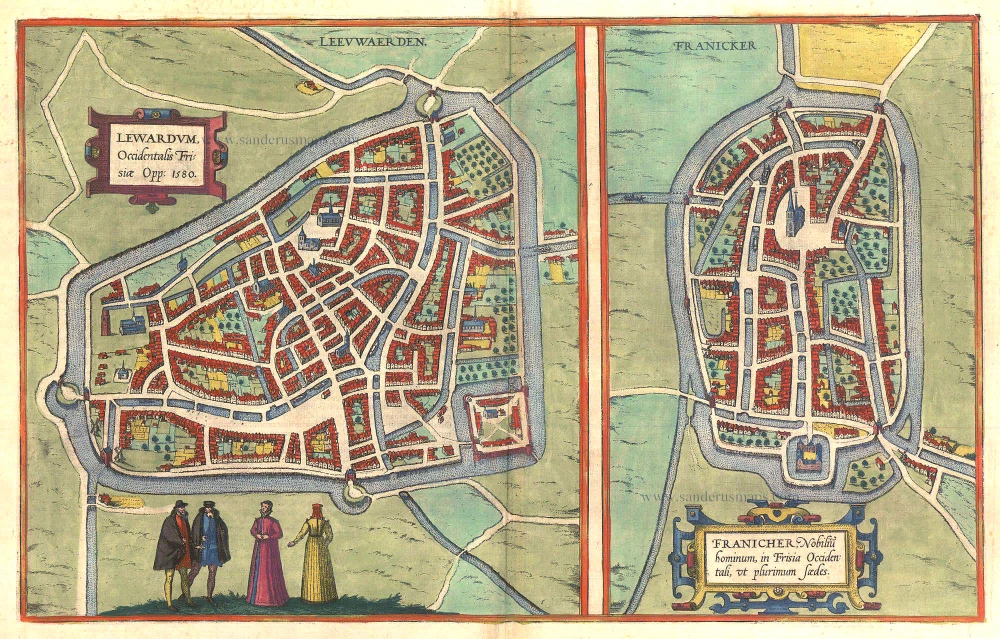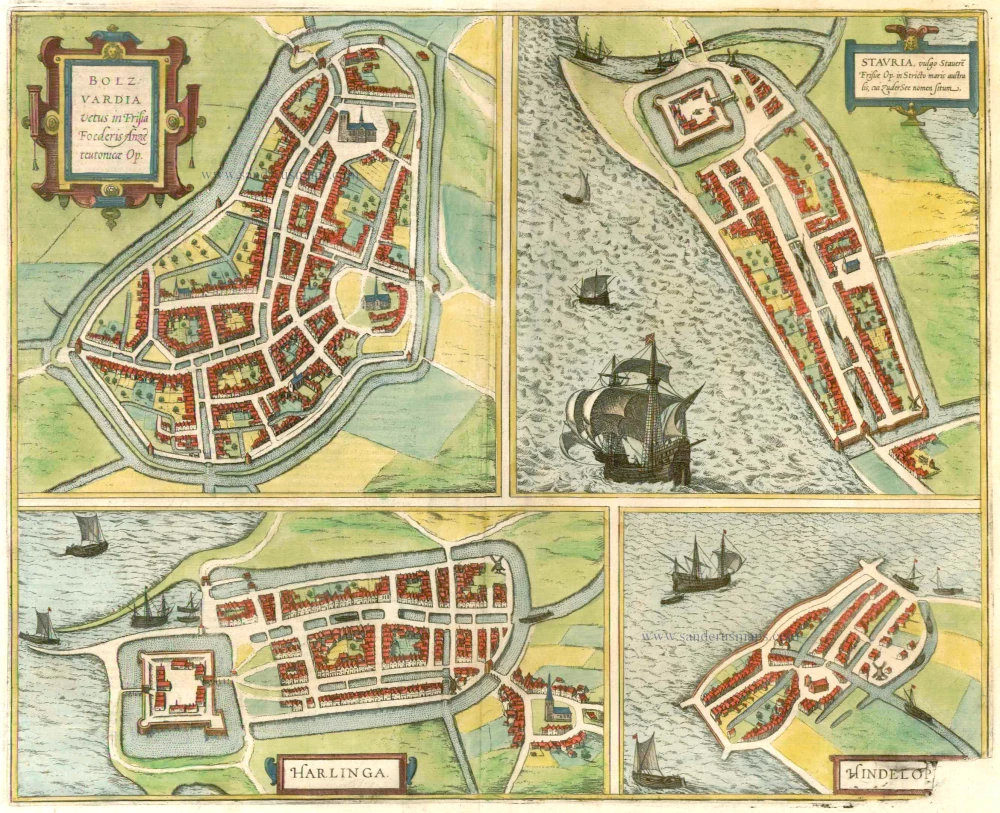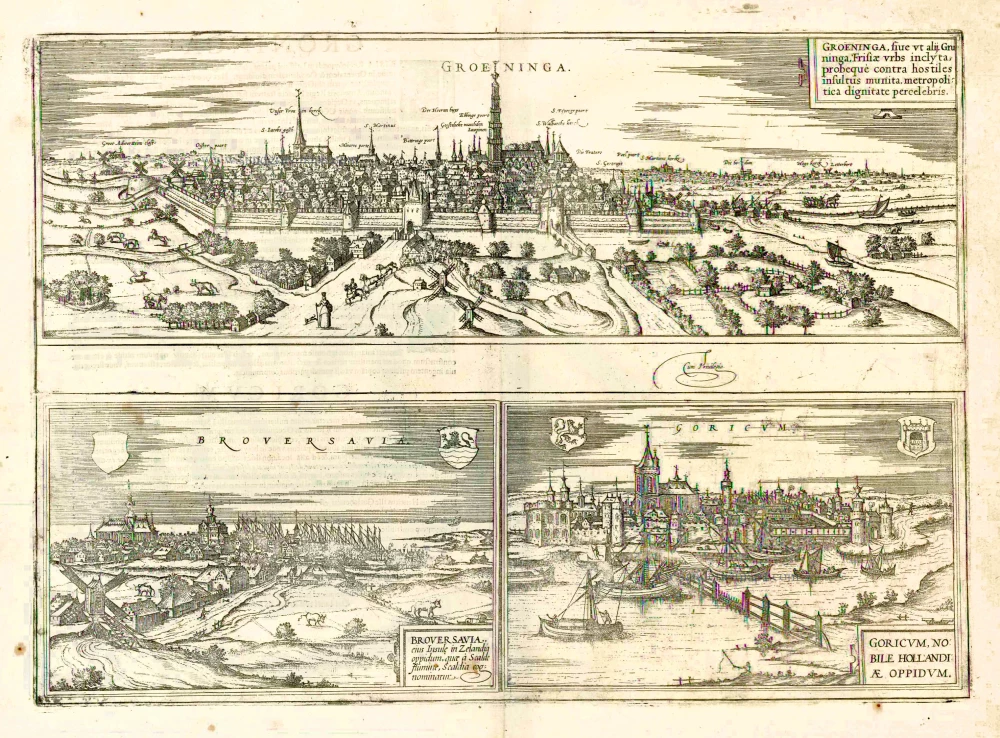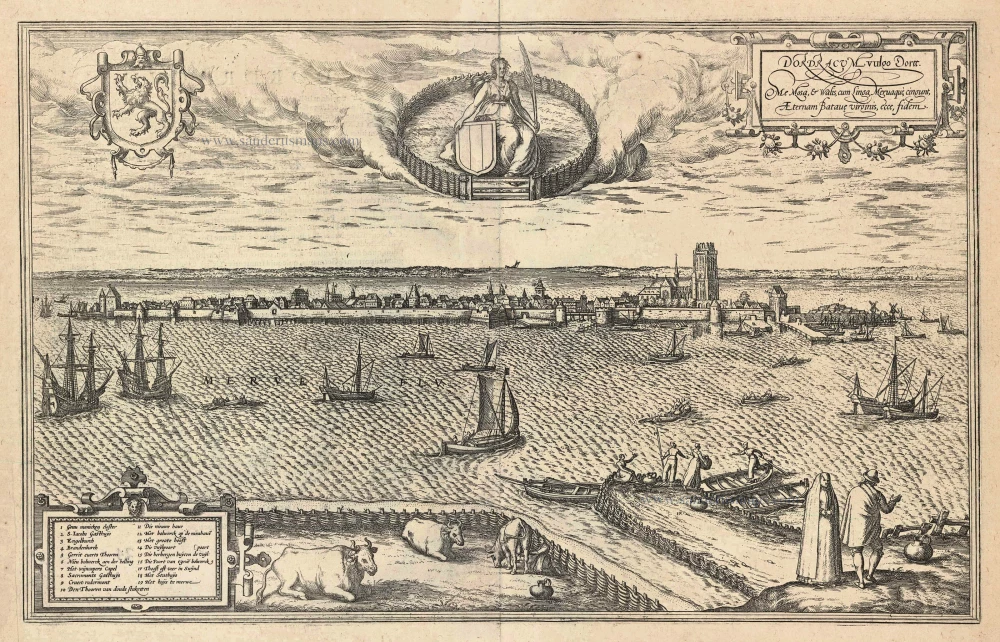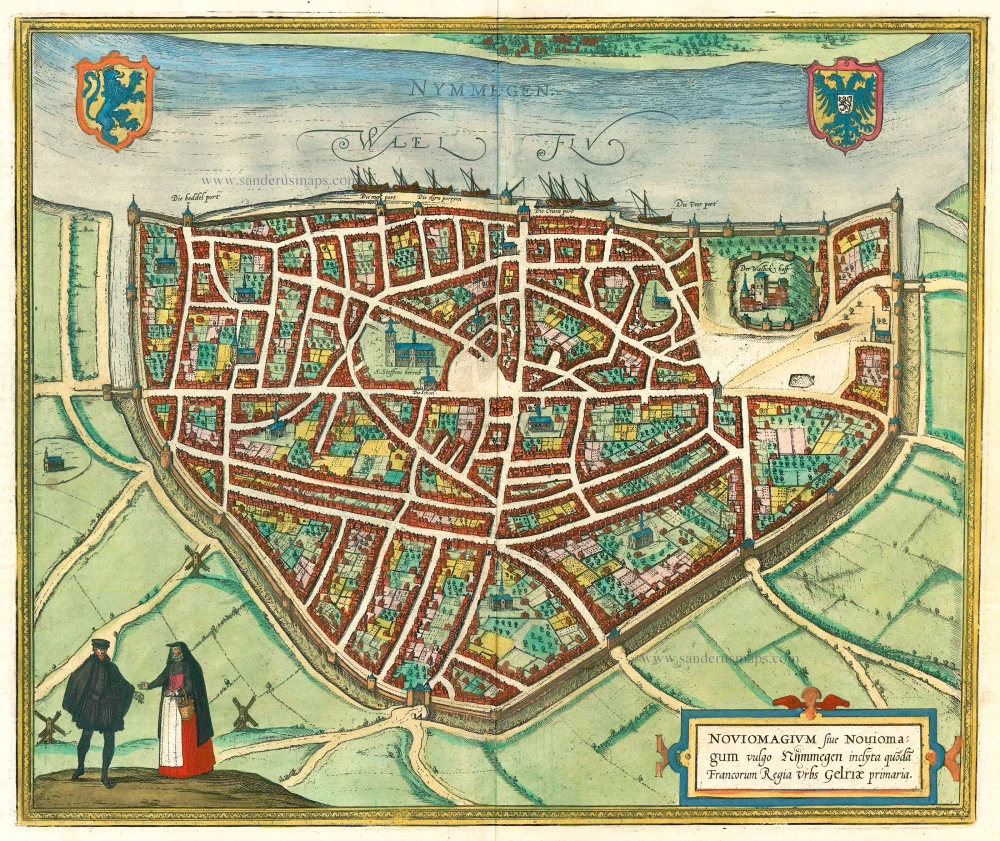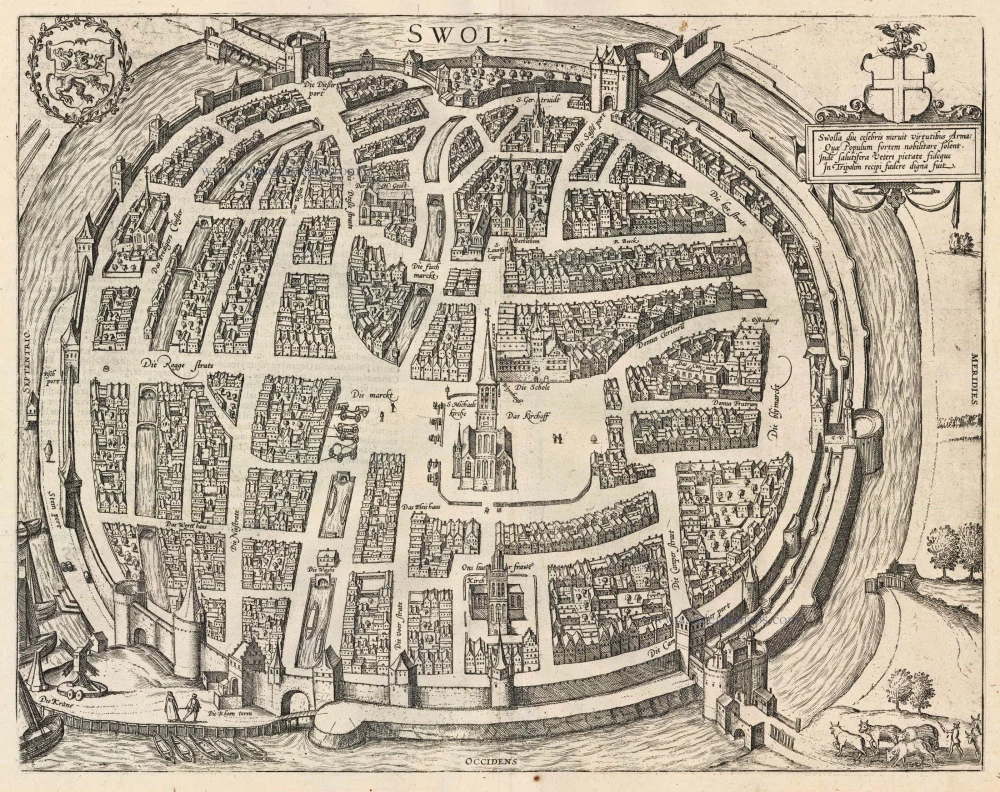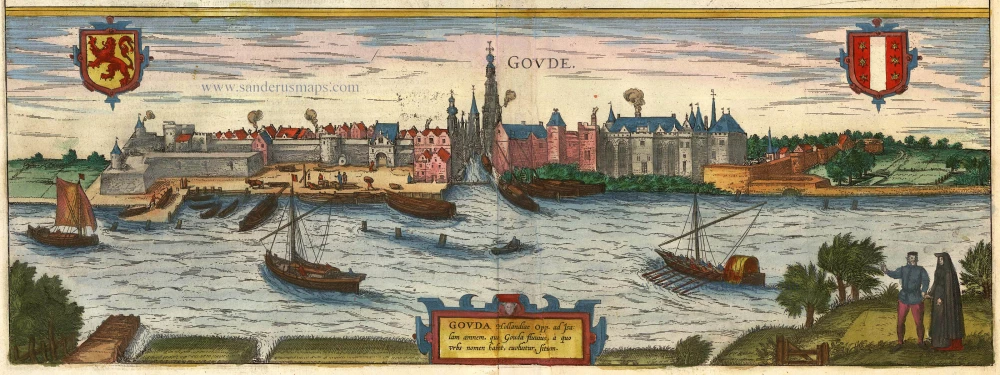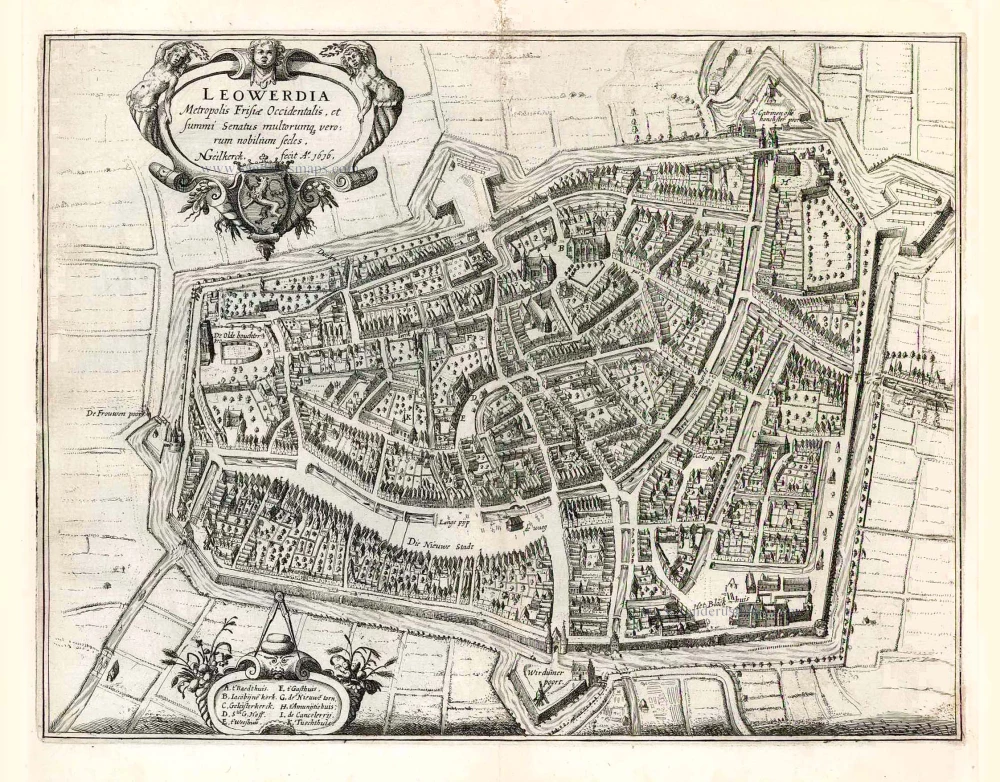Leeuwarden & Franeker by Braun & Hogenberg. 1581-88
LEEUWARDEN
CARTOUCHE: Leeuwarden, a West Frisian town. 1580.
COMMENTARY BY BRAUN: "Leeuwarden lies in West Friesland. Within this county, it is a special town that can boast well-appointed townhouses, but that is also completely surrounded by the river and with its moats and fortified castle can therefore withstand all enemy attacks."
This bird's-eye plan from the year 1580 depicts Leeuwarden, once the seat of the powerful governor of Friesland. On the left-hand edge of the town, a large church is accompanied by a freestanding late Gothic tower, the unfinished Oldehove, still standing today. The Gothic Grote Kerk or Jacobijnerkerk is located in the upper half of the town, while the weight house on the Waagplein is clearly visible in the lower half. In the 15th century, Leeuwarden enjoyed supraregional importance as a river port, a position it lost in the late 16th and 17th centuries, however, as its access to the sea silted up.
Cartographer: Jacob van Deventer
FRANEKER
CARTOUCHE: Franeker in West Friesland, the seat of many noble men.
COMMENTARY BY BRAUN: "Two miles from Leeuwarden lies Franeker, where many self-assured men live, since they valiantly resisted a siege by those staging a revolt against their then sovereign, the Duke of Saxony, and were consequently rewarded with stately privileges and freedoms. It has numerous grazing pastures for cattle as is usual in Friesland, but the land is interspersed with many lakes, pools and marshes."
Franeker, a former university town whose students included René Descartes, lies between Harlingen and Leeuwarden. It is seen here in a bird's-eye view, surrounded by a ring canal and crossed by a number of other canals. Founded around AD 800 as a Carolingian fortress, in the Middle Ages and the early modern era, Franeker developed into an impressive city; in the 15th century, it was chosen by Albert of Saxony as his primary residence. Rising from the centre of the main market square is the late Gothic Martinikerk. Bottom left, on the longest of the canals, is the town hall. (Taschen)
Braun G. & Hogenberg F. and the Civitates Orbis Terrarum.
The Civitates Orbis Terrarum, also known as the 'Braun & Hogenberg', is a six-volume town atlas and the most excellent book of town views and plans ever published: 363 engravings, sometimes beautifully coloured. It was one of the best-selling works in the last quarter of the 16th century. Georg Braun, a skilled writer, wrote the text accompanying the plans and views on the verso. Many plates were engraved after the original drawings of a professional artist, Joris Hoefnagel (1542-1600). The first volume was published in Latin in 1572 and the sixth in 1617. Frans Hogenberg, a talented engraver, created the tables for volumes I through IV, and Simon van den Neuwel made those for volumes V and VI. Other contributors were cartographers Daniel Freese and Heinrich Rantzau, who provided valuable geographical information. Works by Jacob van Deventer, Sebastian Münster, and Johannes Stumpf were also used as references. Translations appeared in German and French, making the atlas accessible to a broader audience.
Since its original publication of volume 1 in 1572, the Civitates Orbis Terrarum has left an indelible mark on the history of cartography. Seven more editions followed the first volume in 1575, 1577, 1582, 1588, 1593, 1599, and 1612. Vol.2, initially released in 1575, saw subsequent editions in 1597 and 1612. The subsequent volumes, each a treasure trove of historical insights, graced the world in 1581, 1588, 1593, 1599, and 1606. The German translation of the first volume, a testament to its widespread appeal, debuted in 1574, followed by the French edition in 1575.
Several printers were involved: Theodor Graminaeus, Heinrich von Aich, Gottfried von Kempen, Johannis Sinniger, Bertram Buchholtz, and Peter von Brachel, all of whom worked in Cologne.
Georg Braun (1541-1622)
Georg Braun, the author of the text accompanying the plans and views in the Civitates Orbis Terrarum, was born in Cologne in 1541. After his studies in Cologne, he entered the Jesuit Order as a novice, indicating his commitment to learning and intellectual pursuits. In 1561, he obtained his bachelor's degree; in 1562, he received his Magister Artium, further demonstrating his academic achievements. Although he left the Jesuit Order, he continued his studies in theology, gaining a licentiate in theology. His theological background likely influenced the content and tone of the text in the Civitates Orbis Terrarum, adding a unique perspective to the work.
Frans Hogenberg (1535-1590)
Frans Hogenberg was a Flemish and German painter, engraver, and mapmaker. He was born in Mechelen as the son of Nicolaas Hogenberg.
By the end of the 1560s, Frans Hogenberg was employed upon Abraham Ortelius's Theatrum Orbis Terrarum, published in 1570; he is named an engraver of numerous maps. In 1568, he was banned from Antwerp by the Duke of Alva and travelled to London, where he stayed a few years before emigrating to Cologne. He immediately embarked on his two most important works, the Civitates, published in 1572 and the Geschichtsblätter, which appeared in several series from 1569 until about 1587.
Thanks to large-scale projects like the Geschichtsblätter and the Civitates, Hogenberg's social circumstances improved with each passing year. He died as a wealthy man in Cologne in 1590.
Lewardum. Occidentalis Frisiae Opp: 1580. [on sheet with:] Franicher, Nobiliu hominum, in Frisia Occidentali, ut plurimum saedes.
Item Number: 20439 Authenticity Guarantee
Category: Antique maps > Europe > The Netherlands - Cities
Old, antique bird’s-eye view plan of Leeuwarden & Franeker by Braun & Hogenberg.
Title: Lewardum. Occidentalis Frisiae Opp: 1580. [on sheet with:] Franicher, Nobiliu hominum, in Frisia Occidentali, ut plurimum saedes.
Cartographer: Jacob van Deventer.
Date: 1581-88.
Copper engraving, printed on paper.
Size (not including margins): 310 x 490mm (12.2 x 19.29 inches).
Verso: Latin text.
Condition: Original coloured, excellent.
Condition Rating: A+.
From: Civitates Orbis Terrarum. . Liber tertius. Köln, G. Kempen, 1581-88. (Koeman, B&H3)
LEEUWARDEN
CARTOUCHE: Leeuwarden, a West Frisian town. 1580.
COMMENTARY BY BRAUN: "Leeuwarden lies in West Friesland. Within this county, it is a special town that can boast well-appointed townhouses, but that is also completely surrounded by the river and with its moats and fortified castle can therefore withstand all enemy attacks."
This bird's-eye plan from the year 1580 depicts Leeuwarden, once the seat of the powerful governor of Friesland. On the left-hand edge of the town, a large church is accompanied by a freestanding late Gothic tower, the unfinished Oldehove, still standing today. The Gothic Grote Kerk or Jacobijnerkerk is located in the upper half of the town, while the weight house on the Waagplein is clearly visible in the lower half. In the 15th century, Leeuwarden enjoyed supraregional importance as a river port, a position it lost in the late 16th and 17th centuries, however, as its access to the sea silted up.
Cartographer: Jacob van Deventer
FRANEKER
CARTOUCHE: Franeker in West Friesland, the seat of many noble men.
COMMENTARY BY BRAUN: "Two miles from Leeuwarden lies Franeker, where many self-assured men live, since they valiantly resisted a siege by those staging a revolt against their then sovereign, the Duke of Saxony, and were consequently rewarded with stately privileges and freedoms. It has numerous grazing pastures for cattle as is usual in Friesland, but the land is interspersed with many lakes, pools and marshes."
Franeker, a former university town whose students included René Descartes, lies between Harlingen and Leeuwarden. It is seen here in a bird's-eye view, surrounded by a ring canal and crossed by a number of other canals. Founded around AD 800 as a Carolingian fortress, in the Middle Ages and the early modern era, Franeker developed into an impressive city; in the 15th century, it was chosen by Albert of Saxony as his primary residence. Rising from the centre of the main market square is the late Gothic Martinikerk. Bottom left, on the longest of the canals, is the town hall. (Taschen)
Braun G. & Hogenberg F. and the Civitates Orbis Terrarum.
The Civitates Orbis Terrarum, also known as the 'Braun & Hogenberg', is a six-volume town atlas and the most excellent book of town views and plans ever published: 363 engravings, sometimes beautifully coloured. It was one of the best-selling works in the last quarter of the 16th century. Georg Braun, a skilled writer, wrote the text accompanying the plans and views on the verso. Many plates were engraved after the original drawings of a professional artist, Joris Hoefnagel (1542-1600). The first volume was published in Latin in 1572 and the sixth in 1617. Frans Hogenberg, a talented engraver, created the tables for volumes I through IV, and Simon van den Neuwel made those for volumes V and VI. Other contributors were cartographers Daniel Freese and Heinrich Rantzau, who provided valuable geographical information. Works by Jacob van Deventer, Sebastian Münster, and Johannes Stumpf were also used as references. Translations appeared in German and French, making the atlas accessible to a broader audience.
Since its original publication of volume 1 in 1572, the Civitates Orbis Terrarum has left an indelible mark on the history of cartography. Seven more editions followed the first volume in 1575, 1577, 1582, 1588, 1593, 1599, and 1612. Vol.2, initially released in 1575, saw subsequent editions in 1597 and 1612. The subsequent volumes, each a treasure trove of historical insights, graced the world in 1581, 1588, 1593, 1599, and 1606. The German translation of the first volume, a testament to its widespread appeal, debuted in 1574, followed by the French edition in 1575.
Several printers were involved: Theodor Graminaeus, Heinrich von Aich, Gottfried von Kempen, Johannis Sinniger, Bertram Buchholtz, and Peter von Brachel, all of whom worked in Cologne.
Georg Braun (1541-1622)
Georg Braun, the author of the text accompanying the plans and views in the Civitates Orbis Terrarum, was born in Cologne in 1541. After his studies in Cologne, he entered the Jesuit Order as a novice, indicating his commitment to learning and intellectual pursuits. In 1561, he obtained his bachelor's degree; in 1562, he received his Magister Artium, further demonstrating his academic achievements. Although he left the Jesuit Order, he continued his studies in theology, gaining a licentiate in theology. His theological background likely influenced the content and tone of the text in the Civitates Orbis Terrarum, adding a unique perspective to the work.
Frans Hogenberg (1535-1590)
Frans Hogenberg was a Flemish and German painter, engraver, and mapmaker. He was born in Mechelen as the son of Nicolaas Hogenberg.
By the end of the 1560s, Frans Hogenberg was employed upon Abraham Ortelius's Theatrum Orbis Terrarum, published in 1570; he is named an engraver of numerous maps. In 1568, he was banned from Antwerp by the Duke of Alva and travelled to London, where he stayed a few years before emigrating to Cologne. He immediately embarked on his two most important works, the Civitates, published in 1572 and the Geschichtsblätter, which appeared in several series from 1569 until about 1587.
Thanks to large-scale projects like the Geschichtsblätter and the Civitates, Hogenberg's social circumstances improved with each passing year. He died as a wealthy man in Cologne in 1590.

